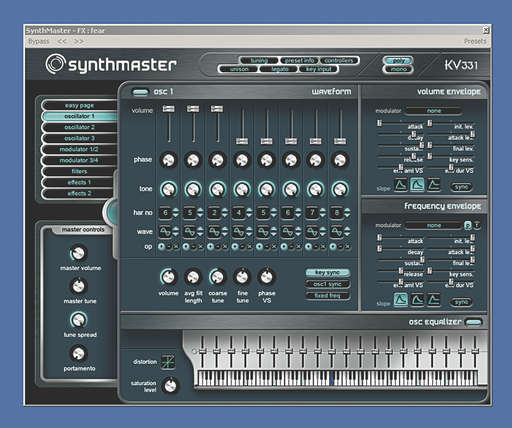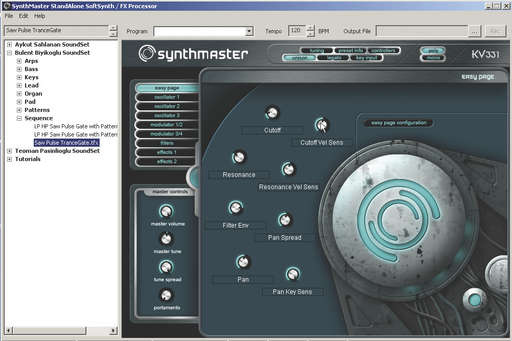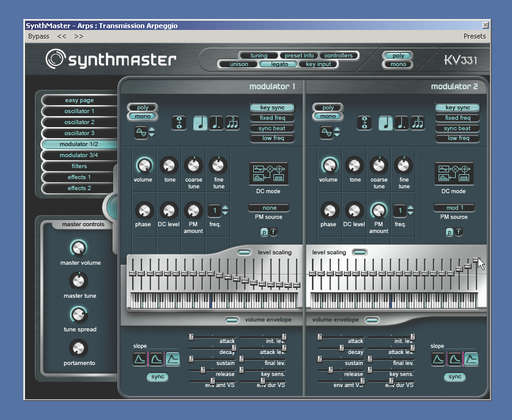MusicRadar Verdict
A powerful new semi-modular synth at a very reasonable price. It's not a must-have by any means, but you should check out the excellent free version at the very least.
Pros
- +
Powerful additive oscillators. Modulation galore. Kudos for the free version. Lots of presets.
Cons
- -
Too many of the presets are drenched in effects. Filter could be smoother. Gain on some presets is far too high.
MusicRadar's got your back

KV331 Audio SynthMaster

KV331 Audio SynthMaster

KV331 Audio SynthMaster
The disciplines of additive and modular synthesis have been pushed to untold extremes. So what can you possibly do with them now? Stick 'em together of course.
KV331 Audio has decided that the best way to move forward is to exploit both additive and modular synthesis in their impressive-looking SynthMaster instrument.
This operates both standalone and as a VST/RTAS plug-in, and also works as an effects processor for incoming audio signals.
Hands on
Fire up SynthMaster for the first time and you're met with the Easy page. This is one of nine that can be accessed via the tabs along the left side of SynthMaster's sharply designed interface.
The Easy page offers controls for quick 'n' dirty editing and, happily, these can be user-defined.
Dig a little deeper and you'll discover that SynthMaster sports a trio of oscillators, another trio of filters, standard envelope generators, LFOs and some powerful pattern generators.
While this list of functions may not seem out of the ordinary at first glance, rest assured that each and every link in the SynthMaster signal chain is fortified with unusual options and added flexibility.
Want all the hottest music and gear news, reviews, deals, features and more, direct to your inbox? Sign up here.
Take those oscillators, for example. No mere analogue clones, these offer eight waves, each of which can generate one of five familiar waveforms (saw, square, sine and so on).
You determine the harmonic frequency, phase and level of each, and the whole lot are added together to produce complex timbres that you wouldn't be able to produce using a standard analogue synthesizer.
As with many other 'additive' synthesizers, SynthMaster's additive functions are pared down for ease of use.
You can't, for example, apply an envelope generator to every wave - only to each of the three oscillators.
This is plenty in most circumstances, though you can't achieve anything like realistic acoustic emulations.
Additional functions include waveshaping and pitch envelopes for each of the three oscillators.
In Use
Your painstakingly crafted additive waveforms can be shuttled through any of the three filters, which, in turn, can be arranged in parallel, series or split configurations.
There are a staggering 23 filter types to choose from, including such exotic treats as Second Order Peaking and Fourth Order Bandpass, and they sound pretty good.
That said, we did detect some zipper noise at high resonance settings.
You can modulate the filters with dedicated envelopes and, for further sonic shaping, connect a waveshaper to the filter output.
Waveshaping is available in 18 different flavours including hard limiting, quantising and clipping.
SynthMaster scores heavily in the area of modulation. Aside from the expected envelope generators and LFOs, you can make use of step-pattern modulators, audio rate modulators and a built-in arpeggiator.
The list of parameters displayed on the Modulation pages is lengthy to say the least and, truth be told, beginners may be left scratching their heads.
Fortunately, there's no shortage of documentation to help you suss everything out and even the greenest of synth enthusiasts can glean something useful from twiddling around with the pattern sliders.
As you might expect, there are built-in effects processors and, as you might also expect, the overuse of them compromises many of the preset patches.
We like the echo (in moderation), but the reverb is best ignored. The dedicated tremolo is a welcome inclusion, and the chorus is, well, a chorus. There's loads of EQ onboard, plus a great vocoder.
Summary
There's a lot to like about SynthMaster - we've touched on only a few of its most interesting functions.
It's a deep instrument, to be sure, but the developers have done a good job of keeping things as user-friendly as can be.
You can save presets for each of the pages, for example. This is a good idea and one that offsets any grumblings about tabbed GUIs.
To sound a note of caution, we should say that we found the volume level of some factory patches to be excruciatingly high. As such, you should mind that gain knob when you're flipping through them.
The good news, though, is that SynthMaster's sound is convincing and thanks to the additive oscillators, it's capable of some intriguing tones.
So SynthMaster is a decent buy - if you don't already have a hard drive full of modular monsters, that is.
Computer Music magazine is the world’s best selling publication dedicated solely to making great music with your Mac or PC computer. Each issue it brings its lucky readers the best in cutting-edge tutorials, need-to-know, expert software reviews and even all the tools you actually need to make great music today, courtesy of our legendary CM Plugin Suite.
